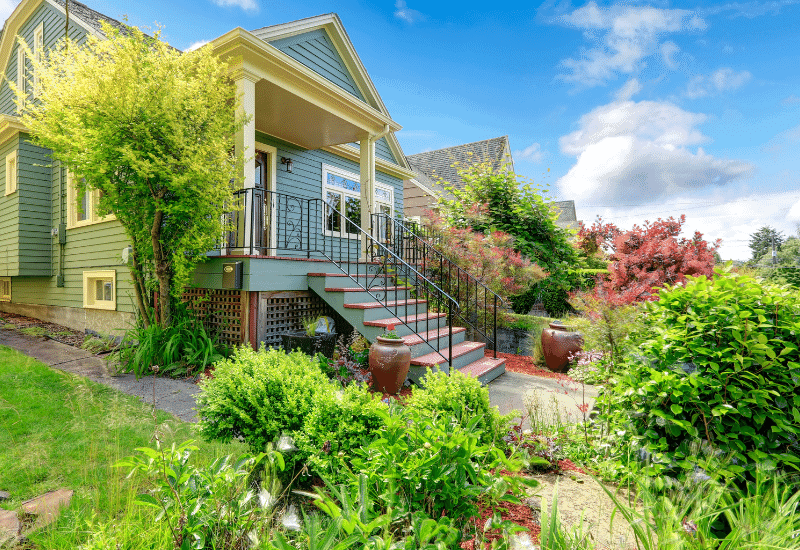
Landscaping in areas with full sun is easy with shrubs that thrive in full sun and tolerant to heat, drought and arid conditions, even in the dog days of summer. No matter how hot it gets, these Sun-loving bushes will offer display of flowers, foliage and berries without demanding more like full blown flower beds might do!
While many flowering, evergreen, and deciduous shrubs flourish in full sun, they’re not all cut from the same cloth. The vibrancy of leaf color, bloom intensity, and overall plant health hinge on the specific light conditions they crave.
So, what shrubs can you plant in your brightly lit landscape that will withstand the sweltering heat and humidity the summer months brings?
Thankfully, there are also plenty of sun worshipers who will not fear the blazing rays of the sun and thriving even in hot, dry settings..
Some will change through the year, as they start a new cycle of buds, blooms and fruiting then turn to autumnal displays of warm tints.
On the other hand, full-sun evergreen shrubs maintain their structure and foliage throughout the year, even during winter’s chill.
Whether you’re seeking large specimens or smaller varieties, or perhaps those with stunning flowers or eye-catching foliage, we’ve curated a list of the top 20 heat-tolerant, sun-loving shrubs ideal for those garden spots that bathe in uninterrupted sunlight for 6 to 8 hours daily.
Bear with me for a second, we will see them all soon, just a little note first: what do we mean by “full Sun”?
When Is Your Shrub in Full Sun?
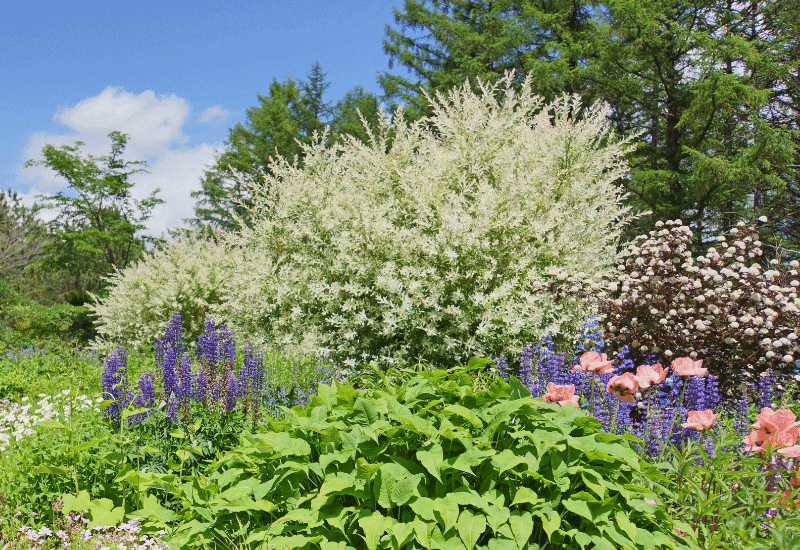
Most people have many more places in full Sun than they actually know, or think. Yes, because “full Sun” means 6 hours or more of bright light a day. It does not mean “strong light” or “direct light”.
The light you get on a moderately cloudy day is bright; the light you get when there is an overcast dark gray sky is not bright.
This to give you the idea… And you only need a morning to get 6 hours a day… In fact, some shrubs like roses, prefer morning light and afternoon on shade when it’s hot, and that still counts as “full Sun”.
So, check your garden for places that fall into this description; you will find many more than you believed.
And now, imagine filling them with the beauties I am going to show you!…
20 Heat-Tolerant Shrubs That Flourish In Scorching Full-Sun Spots
Whether you are looking for low-growing shrubs for the front of the house, evergreen hedges for living privacy or just want abundance of flowers and beautiful fall colors, these carefree shrubs will flower and flourish in full Sun also resist well to heat.
1. ‘Blue Moon’ Hybrid Tea Rose (Rosa ‘Blue Moon’)
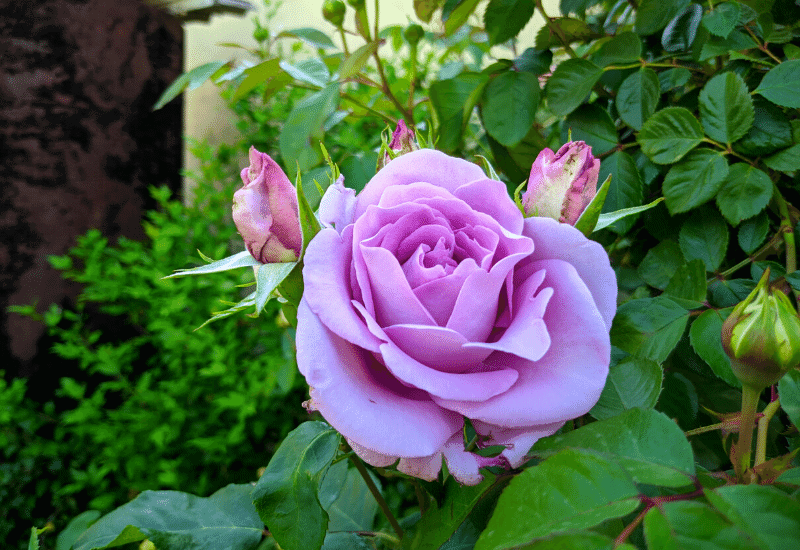
All roses tolerate full Sun, and we have chosen hybrid tea rose ‘Blue Moon’ to show you what an unusual color and strongly fragrant bloom you can get.
The blooms are fully double, with about 40 petals each, they have the typical tea cup shape of this type of roses, and they are large, 4 inches across (10 cm).
The color is very rare though, lavender, fading into pink lavender as the season progresses! They come on long straight stems in the shrubs with fairly glossy and emerald leaves.
‘Blue Moon’ is a hybrid tea rose that will tolerate heat, so, unlike others, it could get the afternoon Sun as well. Ideal for cut flowers, it can fit any informal setting as well as city and courtyard gardens.
2. ‘Kaleidoscope’ Glossy Abelia (Abelia x grandiflora ‘Kaleidoscope’)
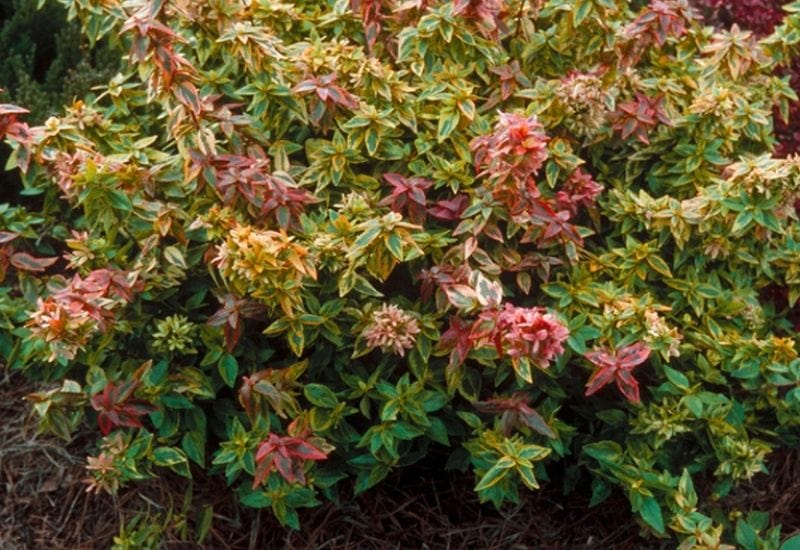
‘Kaleidoscope’ is an apt name for this Sun loving glossy Abelia shrub….that’s what you will get in your garden, in fact. Ok, the foliage is elliptical and tightly packed in the little branches of this bush with a round habit and… They are more than variegated.
You will see green, yellow, orange, red and dark purple combinations on the foliage of this colorful plant!
And the more sunlight it gets, the more it develops warm tints! Then it blossoms and the little flowers are of the best ever color you can get with this Harlequin shrub: white! In fact the only one that would suit…
For an injection of color in beds and borders in open and informal gardens, or in containers on terraces and patios, ‘Kaleidoscope’ glossy Abelia is just perfect!
3. ‘Pygmaea’ Hinoki Cypress (Chamaecyparis obtusa ‘Pygmaea’)
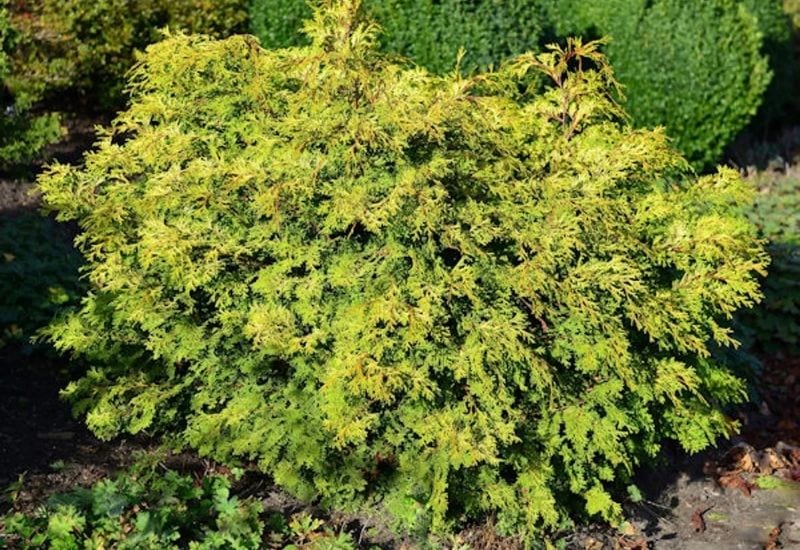
As the name suggests, ‘Pygmaea’ is a small Hinoki cypress is a compact, evergreen shrub which grows best in full Sun to part Sun. It has a very round habit, and this makes it very special indeed; it naturally forms almost perfect spheres of bright green foliage, which turns bronze in winter, but it stays on until spring as it is evergreen.
The branches are fan shaped, which is very unusual indeed and it allows the sculptural appearance of this tiny shrub.
‘Pygmaea’ Hinoki cypress is perfect for sunny borders, for specimen planting and in containers. But it will look good also in rock and Japanese gardens; it also gives you structure and color all year round!
4. ‘Hidcote’ English Lavender (Lavandula anustifolia ‘Hodcote’)
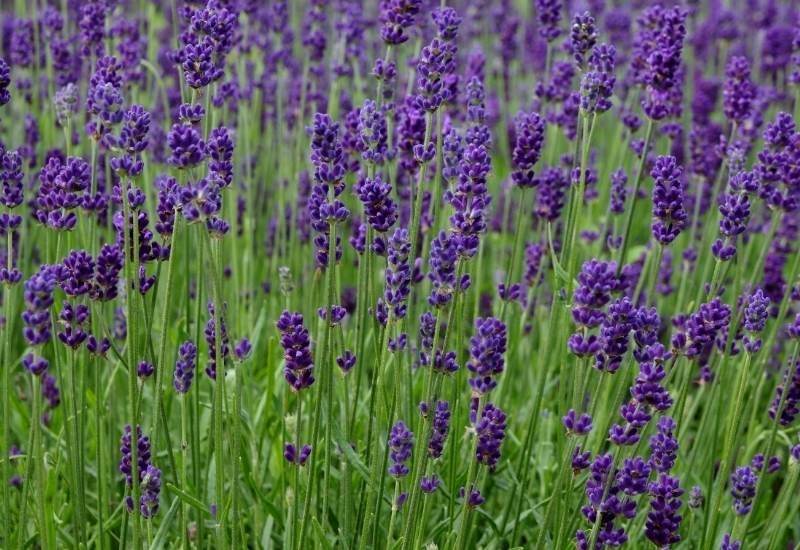
We cannot say “Sun” and “shrub” without mentioning “lavender” too. “But lavender needs hot climates,” you may say, yes, but English lavender is more cold hardy, it has a more fragrant and perfume like scent (as opposed to soap like) and ‘Hidcote’ is a tied and tested popular variety with beautiful, long lasting and very fragrant purple spikes!
It is a winner of the famous Award of Garden Merit by the Royal Horticultural Society, easy to grow, healthy and strong plant!
You can grow it in flower beds, borders, containers in sunny places with confidence; it can even work in more “extreme” settings like formal, courtyard and urban gardens as well as coastal gardens!
5. ‘Variegatum’ Japanese Privet (Ligustrum japonicum ‘Variegatum’)
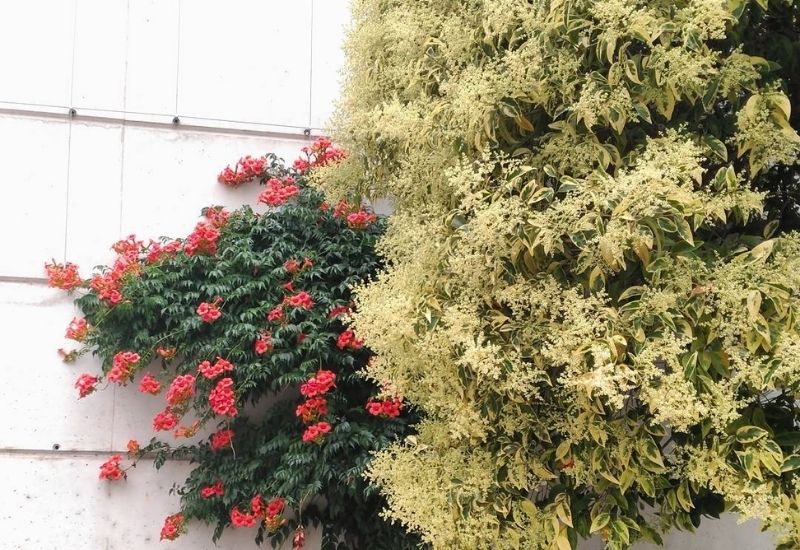
‘Variegatum’ is a colorful evergreen Japanese privet shrub with a lively and bright appearance. The glossy foliage is cream and green, with a naturally dense presence on the branches, which you can improve with pruning.
This multi-stemmed evergreen shrub with an upright spreading habit of growth by Nature and it is a healthy and strong plant that can grow into a large bush. It will also give you cream white flowers in spring and summer.
Ideal for hedges and topiary in full sun sites or gardens, ‘Variegatum’ Japanese privet will also work in big borders. The choice of keeping it in its natural shape or pruning it into a more geometric look depends on you and on the level of formality and informality of your garden.
6. Winged Sumac (Rhus copallinum)
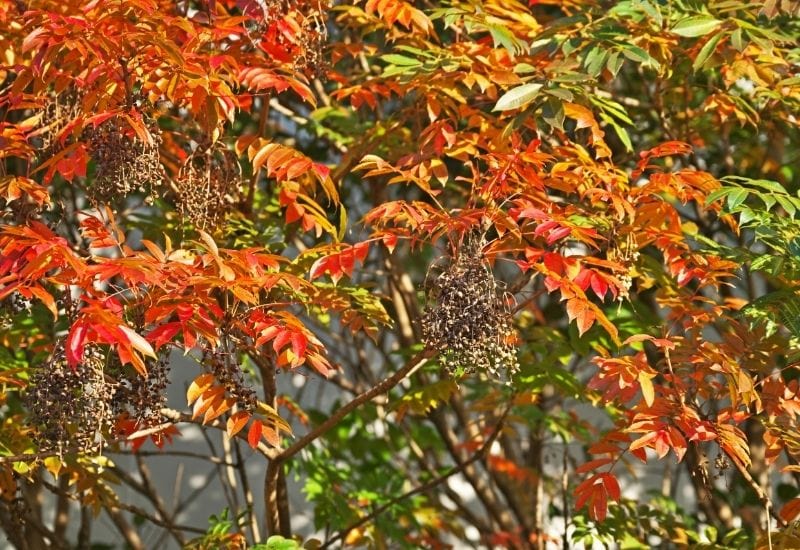
Winged sumac is a very decorative is a large, deciduous shrub or small tree grows well on dry, sandy soils in full sun to part shade places, where it can naturalize and form colonies.
It has shiny, dark green compound leaves with up to 21 leaflets that turn orange and fiery red in fall, giving you a stunning color spectacle. It has a herbaceous appearance and make and female plants.
The blooms are large inflorescences of many small cream flowers, followed by panicles red and fuzzy berries that stay on through winter, when the foliage has gone.
Winged sumac is suited to large naturalized areas, or informal gardens in borders and hedges.
7. ‘Ever Red’ Chinese Fringe Flower (Loropetalum chnense ‘Ever Red’)
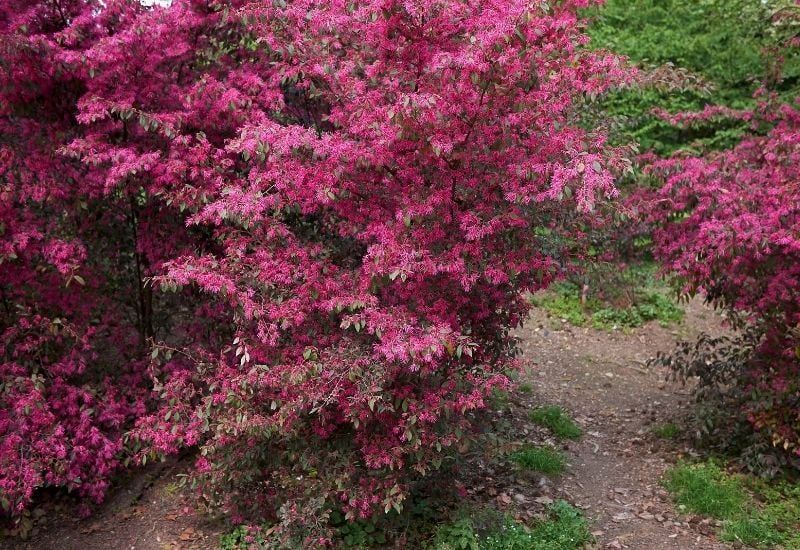
‘Ever Red’ is a bushy variety of Chinese fringe flower with evergreen foliage which will retain color best in full sun. The name suggests that the leaves, round and neatly arranged along the branches are burgundy in color, and they keep this shade all through the warm months.
The flowers are bright crimson red, and they give you a strong but harmonic effect, looking like butterfly wings scattered all over the bush.
‘Ever Red’ Chinese fringe flower is a full sun to part shade loving flowering shrub for all year round color in hedges, borders, beds, screens and even containers. This fast-growing plant also looks great as a wall side shrub.
8. ‘Cherry Parfait’ Grandiflora Rose (Rosa ‘Cherry Parfait’)
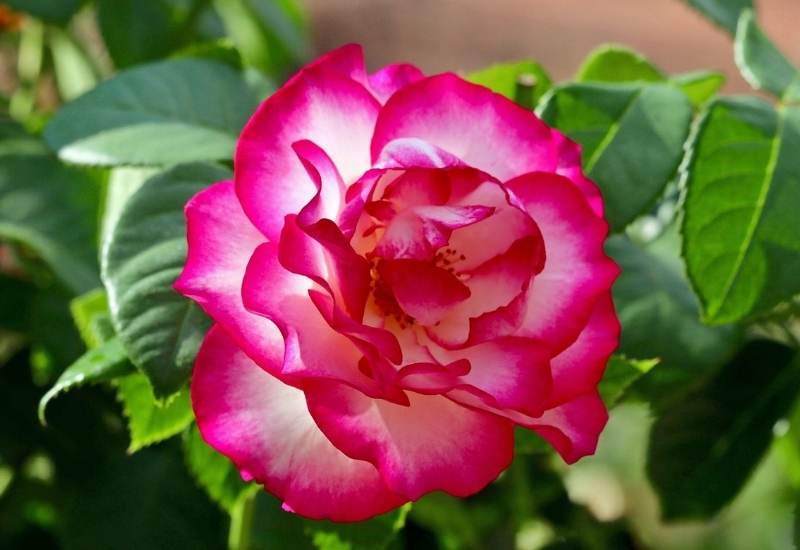
Another Sun loving rose shrub, and this time a jaw dropping grandiflora variety: ‘Cherry Parfait’. Just look at the large (4 inches, or 10 cm) fully double cupped blooms, with about 40 petals each and coming in massive clusters of color!
Yes, because they are white with bright vermilion edges! It’s a show stopping shrub, compact and bushy, and… heat tolerant, which is a sought after in roses to grow in sunny spots. In 2003 it won the All American Rose Selection!
Grow ‘Cherry Parfait’ grandiflora rose in sunny borders, beds or in containers on Sun bathed terraces and patios, you will get all its beauty, its striking colors from spring to frost and… cut flowers too!
9. Elephant Bush (Portulacaria afra)
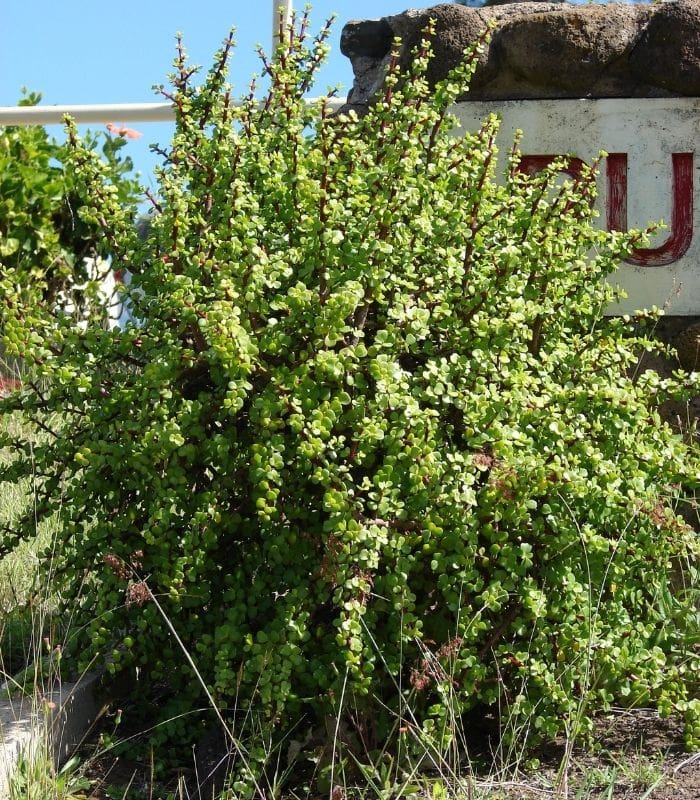
Elephant bush is a succulent and evergreen shrub that can stand any amount of sunlight and heat. It grows long, arching purple branches with small, heart shaped green leaves on them, forming draping bushes that shine in the Sun. It is slow growing but basically impossible to kill.
It will tolerate any amount of drought and heat; it is also edible and medicinal. Eat it against indigestion and use the leaf sap against insect bites.
Elephant bush is perfect in xeric gardens, rock gardens, Mediterranean and coastal gardens, desert deigns, gravel and urban gardens too, as well as containers. Just use your imagination, you won’t get a lower maintenance shrub than this!
10. ‘Holy Grail’ Rose Mallow (Hibiscus ‘Holy Grail’)
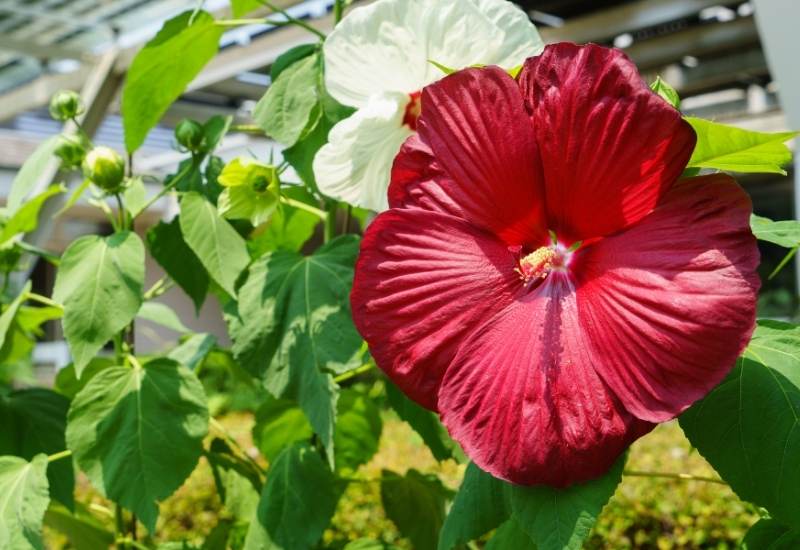
Grows best in full sun and moist, well-drained soil, ‘Holy Grail’ rose mallow is a sun-loving flowering shrubs which produce massive deep red flowers! They are 9 inches across (22 cm), very showy, flat and round impossible to miss.
But this hardy hibiscus hybrid also has longer blooms than other rose mallows, as it will keep blossoming late in the season, sometimes all the way to frost.
But the deciduous foliage is showy too, with its lush purple leaves that make the brightness of the flaming flowers stand out even more!
I would suggest ‘Holy Grail’ rose mallow for any garden that needs a strong dramatic presence; it can be trained into a tree, so it can also fit courtyard, urban and more formal gardens.
11. Oleander (Nerium oleander)
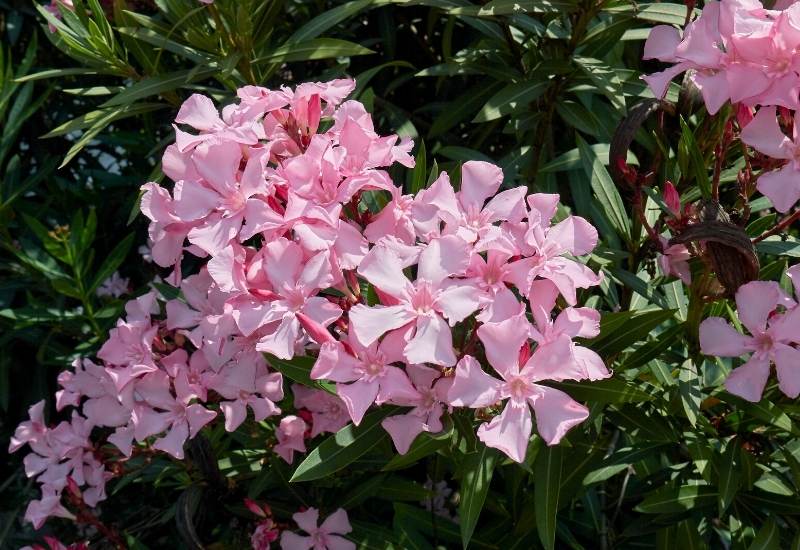
Oleander is a Mediterranean looking evergreen flowering shrub that is synonymous with sunny places. It can tolerate any amount of light and heat, and it can be a marathon bloomer in the right conditions. The blossoms are fragrant, with a vanilla scent, showy and they come in clusters of white, pink or red on the olive and glossy foliage.
You can train them into trees and there are also double varieties, which unusually still have an aroma you can smell from yards away!
Oleander is low maintenance rapidly rounded shrub, though it will require more attention if you form it into a tree. Ideal for Mediterranean and “heat and Sun inspired” designs, it can really work as a hedge or border bush in most informal settings.
12. Harry Lauder’s Walking Stick (Corylus avellana ‘Contorta’)
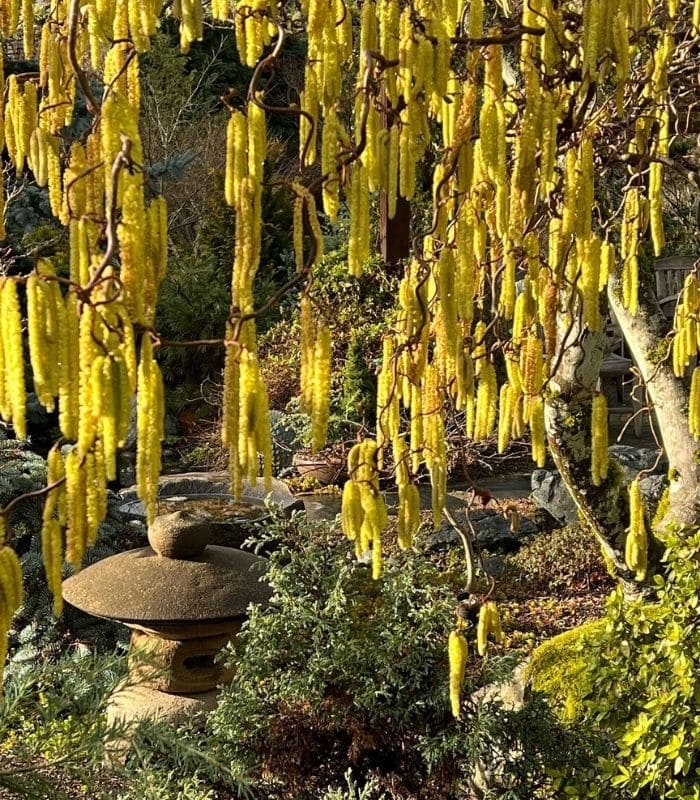
Harry Lauder’s walking stick is a fun variety of hazelnut shrub that looks intriguing in the light. Why? It has twisting branches, that form very unusual, winding shapes that come out perfectly well in winter, when the broad green leaves have dropped.
It will look like a modern sculpture in your garden then, and it will also grow golden yellow catkins in this season, when most green spaces need some source of interest. It’s quirky beauty has gained it the Award of Garden Merit by the Royal Horticultural Society.
You can grow Harry Lauder’s walking stick as a specimen or in hedges and shields, but it only suits informal and traditional gardens; in a formal one, it would look like Nature is playing a trick on you! Too wild!
13. ‘Kinshiden’ Japanese Quince (Chaenomeles speciosa ‘Kinshiden’)
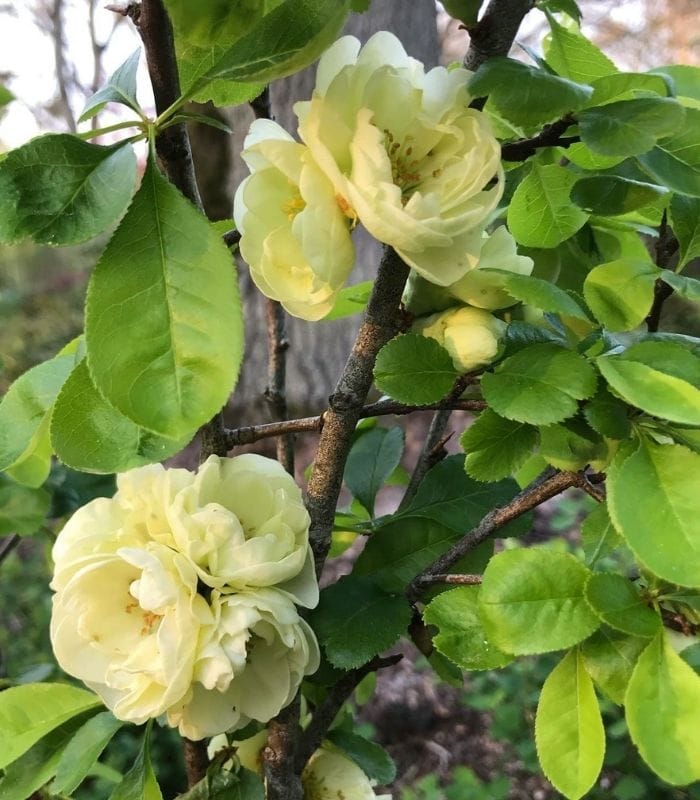
You can really choose any Japanese quince shrub if you have sunny areas in your garden, pink, red, white, but ‘Kinshiden’ is an exceptional variety…
Chaenomeles speciosa ‘Kinshiden‘ is a spreading, medium-sized thorny deciduous shrub with dark green leaves and abundant clusters of double pale lemony-green flowers in spring.
This is a difficult flower color to get in full Sun, so we wanted to show you the range of what you can achieve.
It’s lime green flowers can freshen up the hot days, followed by aromatic yellow fruits that brighten up the rich deep green foliage…
Japanese quince varieties like ‘Kinshiden’ performs best in full sun or part-shade and they are ideal in borders, hedges, screens and as wall side shrubs in all informal gardens, especially traditional ones.
14. ‘Diablo’ Common Ninebark (Physocarpus opulifolius ‘Diablo’)
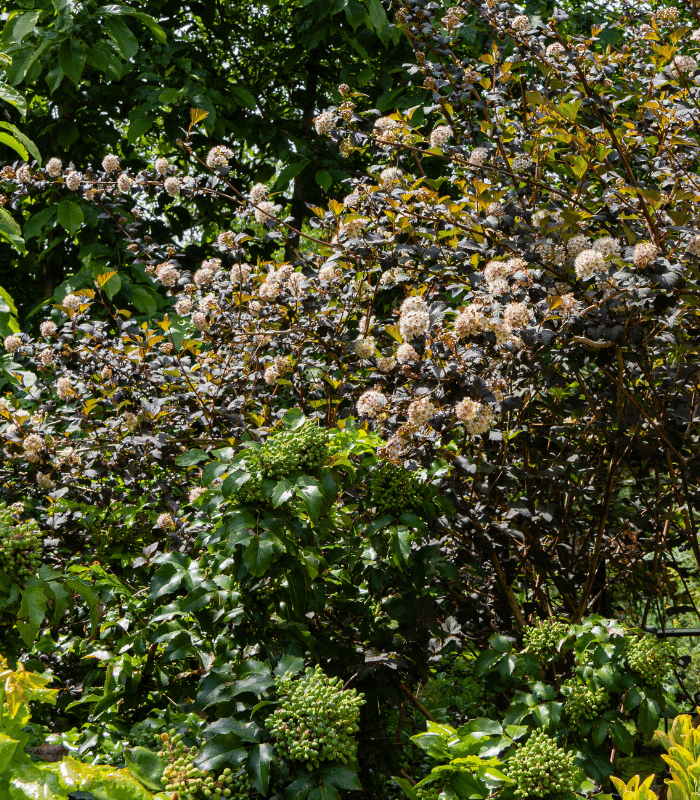
Native to North America ‘Diablo’ common ninebark is a stunning multi-stemmed deciduous shrub with an upright spreading habit, and does best in full sun to partial shade!
The leaves are maple shaped, and very dark purple indeed, and they come on arching branches that give this bush a “fountain” look. However the foliage will fade to green in partial shade or very hot climates.
It also has a naturally exfoliating bark. And… the round inflorescences of white blooms come at the end of the branches and stand out very well against the dark foliage, attracting butterflies and pollinators. It has won the Award of Garden Merit by the Royal Horticultural Society.
‘Diablo’ common ninebark is a herbaceous looking shrub, so suitable for informal borders and hedges. But it is very cold hardy, so you can have it where winters are severe.
15. Cape Jasmine (Gardenia jasminoides ‘Belmont’)
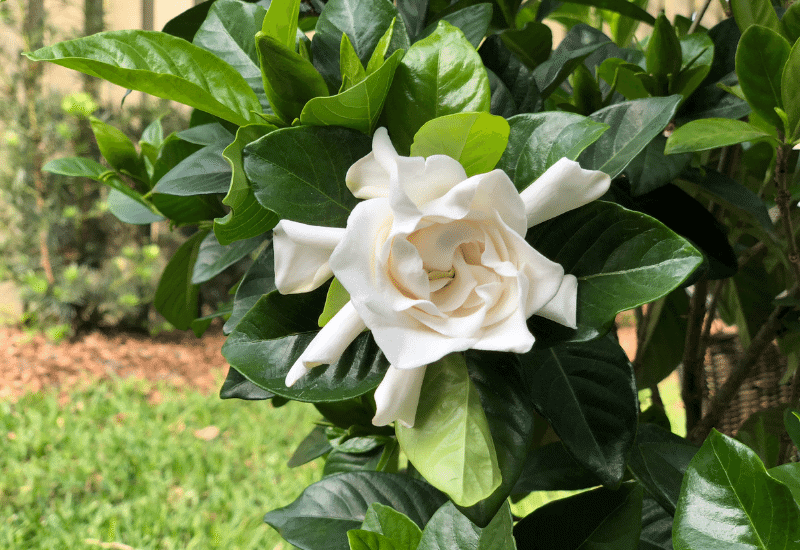
If you need a shrub in a brightly lit spot which does not get too hot, gardenia shrubs are a good choice, and we have picked a spectacular cultivar for you: ‘Belmont’!
With its pure white semi double flowers reaching 4 inches across (10 cm) it is a very showy variety, and it is also a strong bloomer…
In fact, after the first burst, it will give you other smaller all the way to frost. And of course they look amazing against the dark green and glossy foliage.
‘Belmont’ gardenia is great for borders and hedges, but… It is also easy to grow in containers and among the varieties of this species this is one of the best if you want to have it indoors.
16. Big Berry Manzanita (Arctostaphylos glauca)
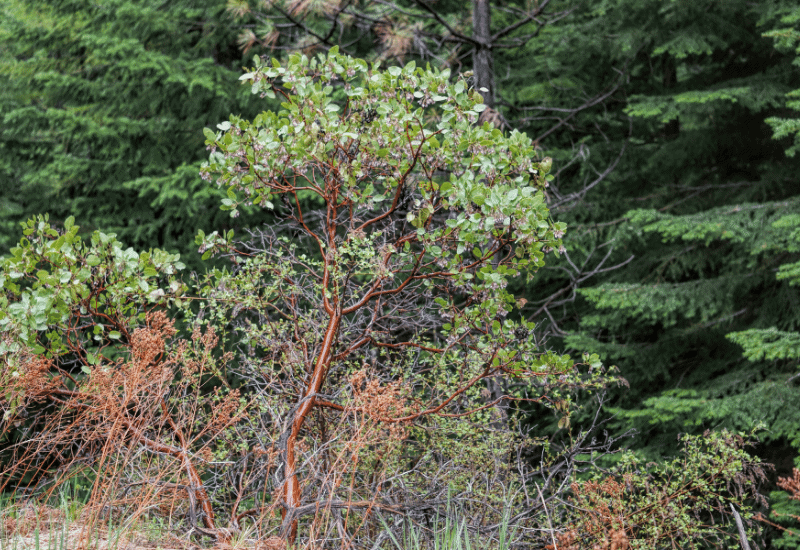
Big berry manzanita is a large Sun loving and heat tolerant shrub with great foliage, blooms and berries… The leaves are oval and fleshy, small and blue green in color; the nodding blooms are white and lantern shape, small too, but very pretty and abundant.
And the berries are the biggest you will find on a manzanita bush; they are ½ inch across (1 cm) and red when mature, when you can harvest them and eat them, or make drinks with them. But be quick, because birds love them too, and they will not miss your garden.
Big berry manzanita has that special Native American look as a shrub, as it has a place in this people’s history. Ideal for a dry or Mediterranean garden, it looks great on banks and slopes and in hedges.
17. Fan Aloe (Aloe plicatilis)
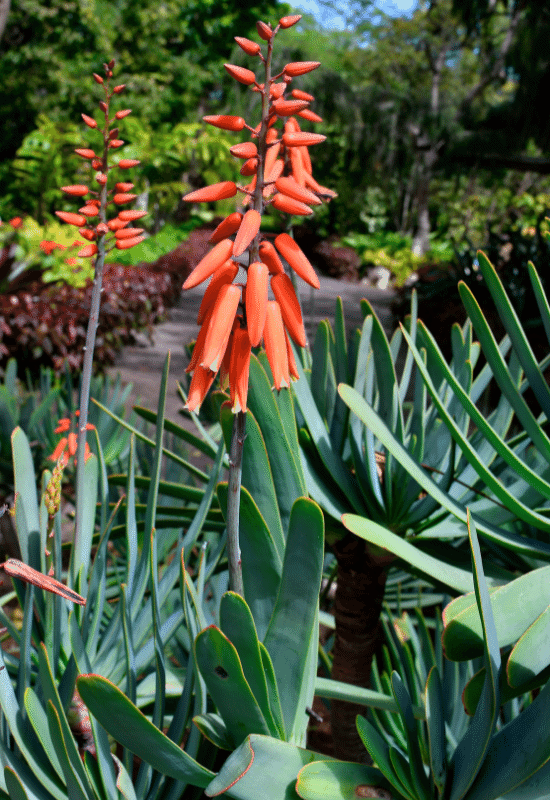
Fan aloe is a sculptural, decorative evergreen shrub forming succulent that really males the best of sunlight.
In fact, the blue leaves will take on orange and red shades at their tips when the Sun is strong. And the foliage is strap shaped, bending regularly and with a smooth surface and round tip.
It creates a very unusual bush, and the long spikes of bright orange red blooms will rise above the foliage with elegance and style! It is a worthy winner of the Award of Garden Merit by the Royal Horticultural Society.
Fan aloe is an very striking shrub for color, shale and texture. It needs to be placed where everybody can see it’ ideally in a large rock garden, a coastal one or a Mediterranean setting.
But even against gravel in urban and courtyard gardens it is just fantastic!
18. ‘Flamingo’ Willow (Salix integra ‘Flamingo’)
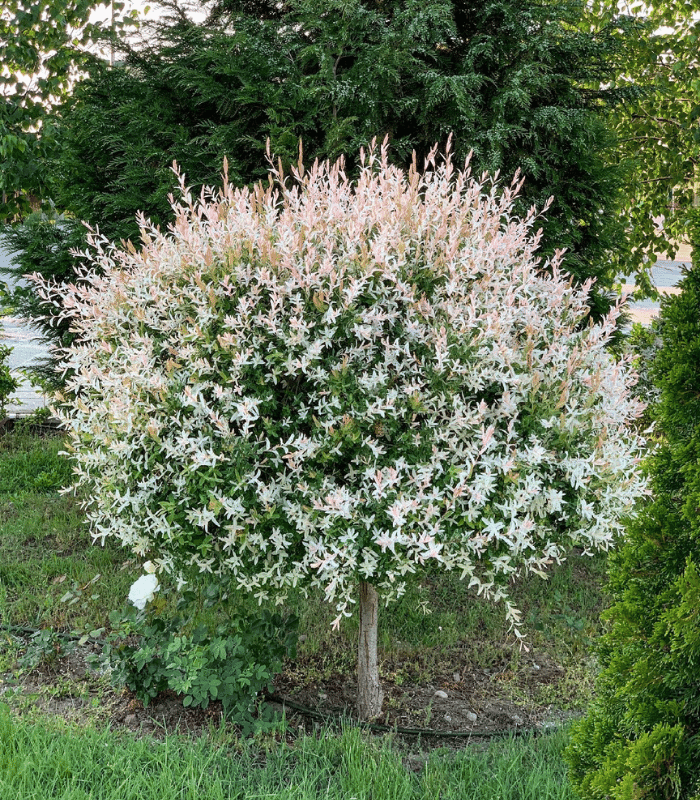
‘Flamingo’ is a shrub forming cultivar of willow that needs lot of light to produce its amazing colors. The foliage in fact is very variegated, with shades of blue, green, white and pink.
The younger foliage in particular is very colorful, and it comes with its long elliptical shapes on straight orange branches arranged in a fan shape. This gives this bus a round habit, but you can prune it to keep it in shape if you need.
The burst of colors that ‘Flamingo’ willow can bring to your garden is hard to describe, It will suit virtually any informal setting and, trimmed appropriately, it may even fit into a formal design.
19. Evergreen Dogwood (Cornus capitata)
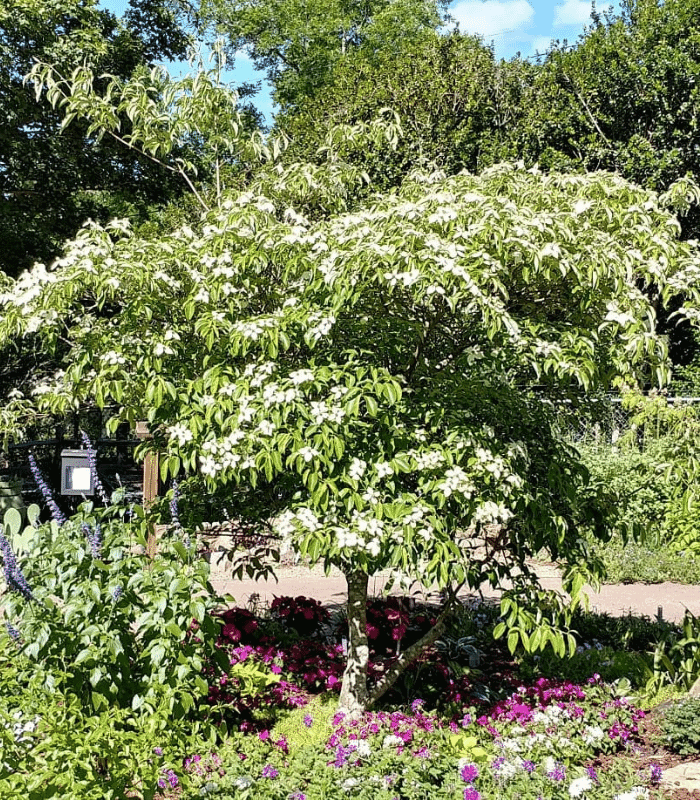
Evergreen dogwood is an impressive shrub or small tree to grow in a sun bathed garden!
The leathery leaves are broad, elliptical and curved, mid green in color, but they turn purple and red in fall. The flowers are very showy, cream white and with four round bracts that look like petals, flat in shape.
But maybe its most amazing asset are the red berries that come in clusters late in the season; they are very unusual, and they almost look like big strawberries! It’s a very exotic plant, a hard one to miss…
Despite its tropical look, evergreen dogwood is good for any natural looking and informal garden; it mixes well with temperate plants and trees, but it can add a twist to your planting, even in English country and cottage gardens. Of course if your garden has a tropical theme, do go ahead!
20. ‘Goldfinger’ Shrubby Cinquefoil (Potentilla fruticosa ‘Goldfinger’)
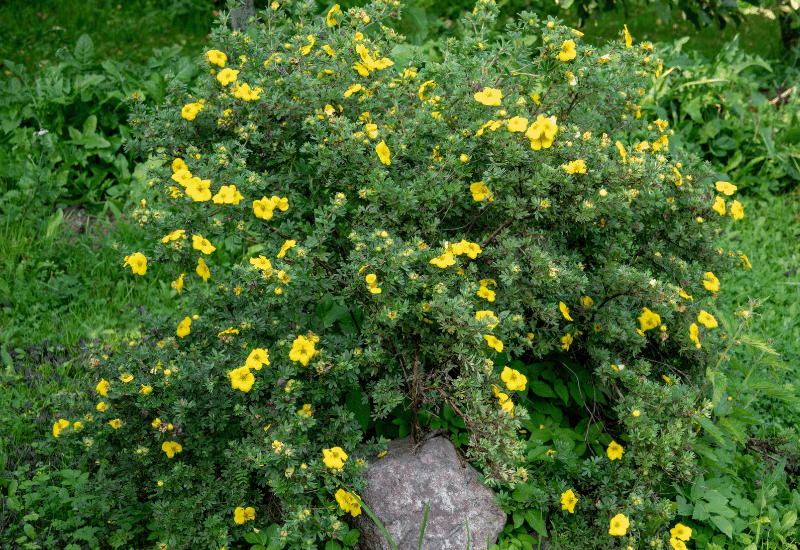
‘Goldfinger’ shrubby cinquefoil forms very thick, rambling and fast spreading flowering bushes with very finely textured deciduous green foliage that is best viewed in the Sun.
The green leaves are small but packed very tightly on the slender stems, and they give you the idea of a cushion of dark green embroidery.
But this Sun loving plant is also a marathon bloomer, starting in spring and giving flowers all the way to frost! Each blossom is 1.5 inches across (4.0 cm) and with five golden yellow petals.
At its peak, the blooms cover the foliage almost completely, at other times they are dotted all over the shrubs.
‘Goldfinger’ shrubby cinquefoil is ideal to bring light and texture to informal gardens, in borders, hedges and flower beds.
Most styles and designs will accommodate it, but natural and traditional ones are best. And it’s very cold hardy too, fine for Canada and the northern states!
Shrubs for Sunny Places
You can get any shape color and personality of shrubs in sunny places; from bright and eye catching roses and hibiscus to delicate berry bearing bushes, evergreens and exotic or even desert looking plants…
You really have a wide choice as you can see, so… have you picked one yet?

Written By
Amber Noyes
Amber Noyes was born and raised in a suburban California town, San Mateo. She holds a master’s degree in horticulture from the University of California as well as a BS in Biology from the University of San Francisco. With experience working on an organic farm, water conservation research, farmers’ markets, and plant nursery, she understands what makes plants thrive and how we can better understand the connection between microclimate and plant health. When she’s not on the land, Amber loves informing people of new ideas/things related to gardening, especially organic gardening, houseplants, and growing plants in a small space.
